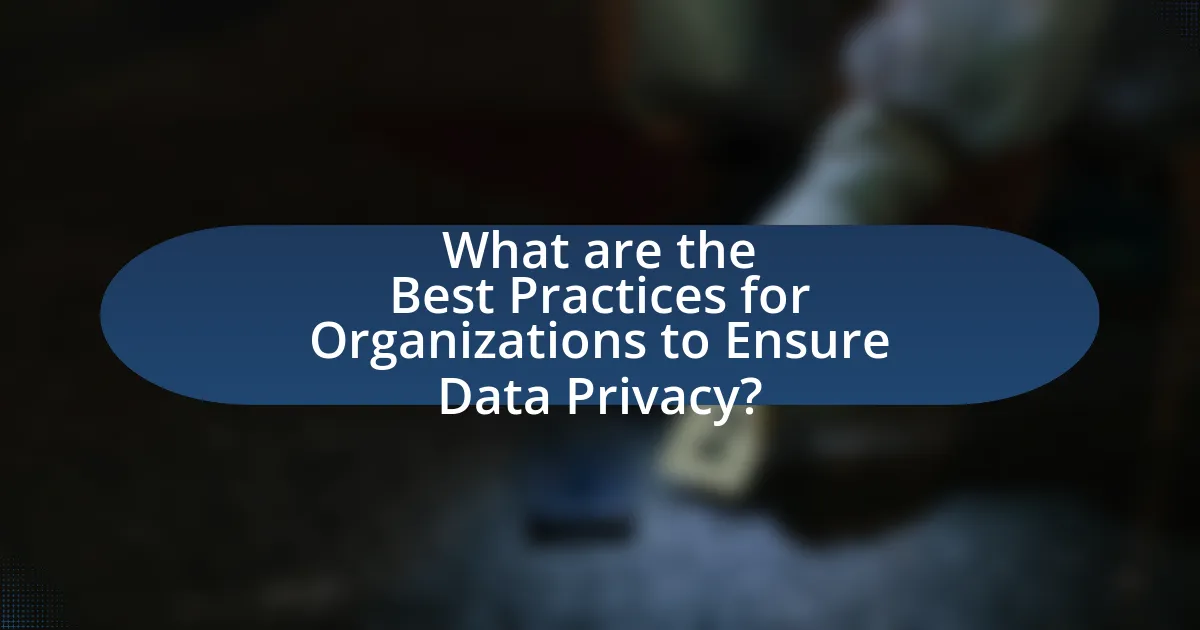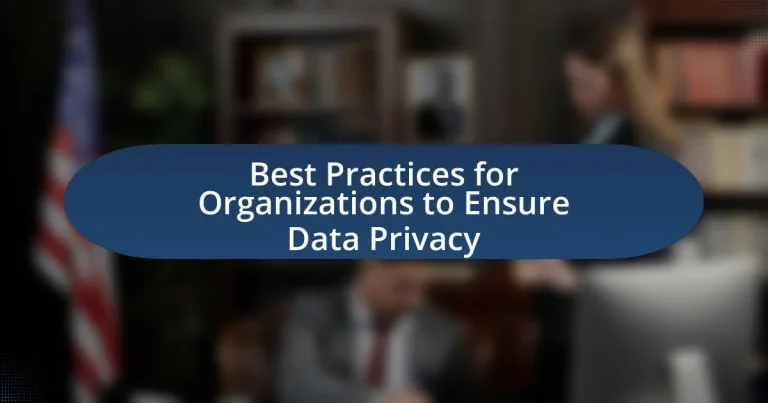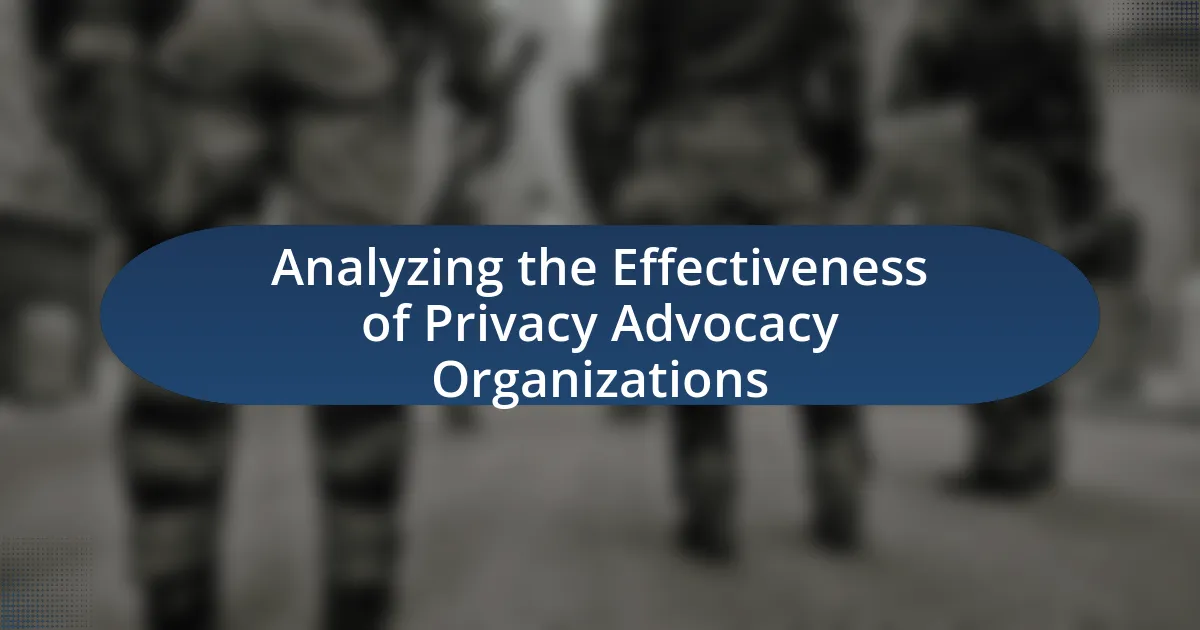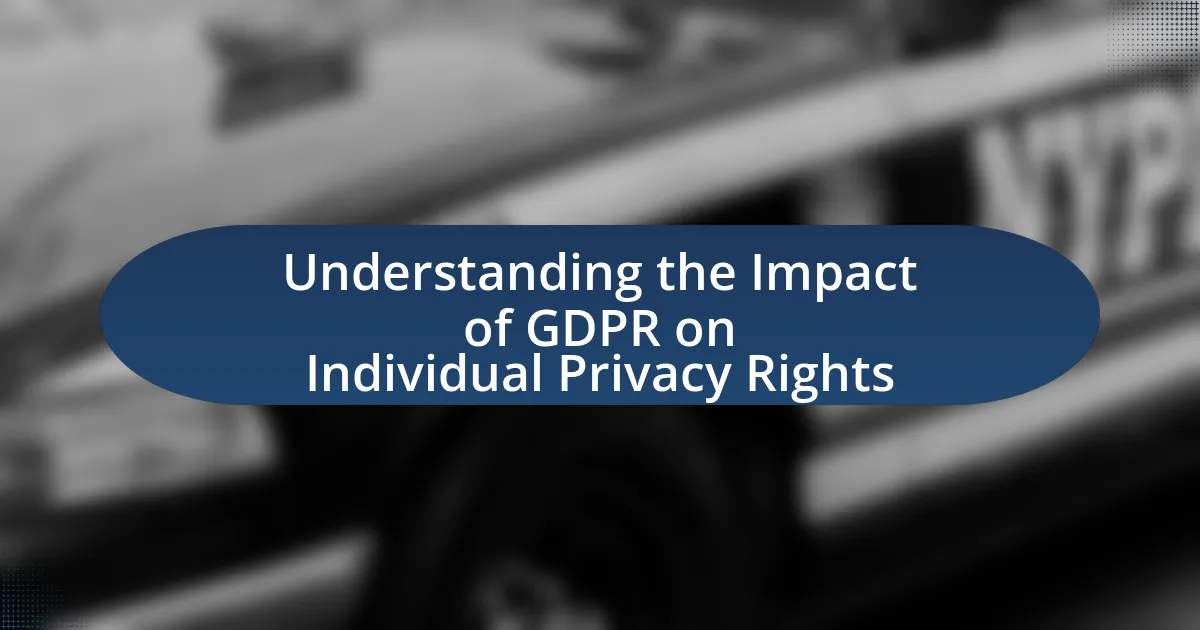The article focuses on best practices for organizations to ensure data privacy, emphasizing the importance of robust data protection policies, regular risk assessments, and employee training. It highlights the critical role of data privacy in maintaining customer trust and compliance with regulations such as GDPR and CCPA, while outlining the potential risks of neglecting data privacy, including data breaches and legal penalties. Key components of an effective data privacy strategy are discussed, including data inventory, policy development, and incident response planning, alongside the significance of technology and employee training in enhancing data privacy practices. The article also addresses the challenges organizations face in ensuring data privacy and provides practical tips for fostering a culture of data privacy awareness.

What are the Best Practices for Organizations to Ensure Data Privacy?
Organizations can ensure data privacy by implementing robust data protection policies, conducting regular risk assessments, and providing employee training on data handling practices. Establishing clear data governance frameworks helps define roles and responsibilities regarding data privacy. Regularly updating security measures, such as encryption and access controls, mitigates risks associated with data breaches. According to the 2021 Verizon Data Breach Investigations Report, 85% of breaches involved human error, highlighting the importance of employee training in safeguarding data. Additionally, compliance with regulations like GDPR and CCPA reinforces organizational commitment to data privacy and builds trust with stakeholders.
Why is Data Privacy Important for Organizations?
Data privacy is crucial for organizations because it protects sensitive information from unauthorized access and breaches, thereby maintaining customer trust and compliance with legal regulations. Organizations that prioritize data privacy can prevent financial losses; for instance, the average cost of a data breach in 2023 was estimated at $4.45 million, according to IBM’s Cost of a Data Breach Report. Furthermore, adherence to data privacy laws, such as the General Data Protection Regulation (GDPR), is essential to avoid hefty fines and legal repercussions, which can reach up to 4% of annual global revenue. Thus, effective data privacy practices not only safeguard organizational assets but also enhance reputation and customer loyalty.
What are the potential risks of neglecting data privacy?
Neglecting data privacy can lead to significant risks, including data breaches, identity theft, and legal penalties. Data breaches expose sensitive information, which can result in financial loss and reputational damage for organizations. For instance, the 2020 Verizon Data Breach Investigations Report indicated that 86% of breaches were financially motivated, highlighting the economic impact of inadequate data protection. Additionally, identity theft can occur when personal data is mishandled, affecting individuals’ financial security and trust in organizations. Legal penalties can arise from non-compliance with regulations such as the General Data Protection Regulation (GDPR), which imposes fines up to 4% of annual global revenue for violations. These risks underscore the critical importance of prioritizing data privacy in organizational practices.
How does data privacy impact customer trust?
Data privacy significantly impacts customer trust by influencing perceptions of security and reliability. When organizations implement robust data privacy measures, customers feel more secure in sharing their personal information, leading to increased trust. According to a 2021 survey by Cisco, 86% of consumers are concerned about data privacy, and 49% would stop engaging with a brand after a data breach. This demonstrates that effective data privacy practices not only protect customer information but also foster loyalty and long-term relationships.
What are the key components of an effective data privacy strategy?
An effective data privacy strategy includes key components such as data inventory, risk assessment, policy development, employee training, and incident response planning. Data inventory involves cataloging all data assets to understand what information is collected and stored. Risk assessment identifies potential vulnerabilities and threats to data privacy, allowing organizations to prioritize their efforts. Policy development establishes clear guidelines for data handling, ensuring compliance with regulations like GDPR and CCPA. Employee training educates staff on data privacy practices and their responsibilities, reducing the likelihood of breaches. Finally, incident response planning prepares organizations to respond swiftly to data breaches, minimizing damage and ensuring regulatory compliance. These components collectively enhance an organization’s ability to protect sensitive information and maintain trust with stakeholders.
What policies should organizations implement for data privacy?
Organizations should implement comprehensive data privacy policies that include data minimization, user consent, access controls, data encryption, and regular audits. Data minimization ensures that only necessary information is collected, reducing exposure to breaches. User consent policies require organizations to obtain explicit permission from individuals before collecting or processing their data, aligning with regulations like GDPR. Access controls limit data access to authorized personnel, mitigating risks of internal breaches. Data encryption protects sensitive information both in transit and at rest, making it unreadable to unauthorized users. Regular audits assess compliance with privacy policies and identify potential vulnerabilities, ensuring ongoing protection of personal data. These practices are essential for maintaining trust and compliance with legal standards.
How can organizations ensure compliance with data privacy regulations?
Organizations can ensure compliance with data privacy regulations by implementing comprehensive data governance frameworks. These frameworks should include regular audits, employee training on data protection policies, and the establishment of clear data handling procedures. For instance, the General Data Protection Regulation (GDPR) mandates that organizations conduct Data Protection Impact Assessments (DPIAs) to identify and mitigate risks associated with personal data processing. Additionally, organizations must maintain transparent data processing records and ensure that consent mechanisms are clear and compliant with legal standards. By adhering to these practices, organizations can effectively manage compliance risks and protect individuals’ privacy rights.
What role does employee training play in data privacy?
Employee training plays a crucial role in data privacy by equipping staff with the knowledge and skills necessary to handle sensitive information responsibly. Effective training programs raise awareness about data protection regulations, such as the General Data Protection Regulation (GDPR), and teach employees how to recognize and respond to potential data breaches. According to a study by the Ponemon Institute, organizations that invest in comprehensive data privacy training can reduce the likelihood of data breaches by up to 70%. This demonstrates that well-trained employees are essential for maintaining data security and compliance within organizations.
How can organizations effectively train employees on data privacy?
Organizations can effectively train employees on data privacy by implementing comprehensive training programs that include regular workshops, e-learning modules, and real-world scenarios. These programs should cover key topics such as data protection laws, company policies, and best practices for handling sensitive information. Research indicates that organizations with ongoing training see a 70% reduction in data breaches, highlighting the importance of continuous education. Additionally, incorporating assessments and feedback mechanisms can reinforce learning and ensure employees understand their responsibilities regarding data privacy.
What are common data privacy mistakes made by employees?
Common data privacy mistakes made by employees include sharing sensitive information through unsecured channels, failing to use strong passwords, and neglecting to update software regularly. Employees often share confidential data via email or messaging apps without encryption, exposing it to unauthorized access. Additionally, many employees use weak passwords or reuse them across multiple accounts, making it easier for cybercriminals to gain access to sensitive information. Furthermore, neglecting software updates can leave systems vulnerable to security breaches, as outdated software may contain known vulnerabilities that attackers can exploit. These mistakes highlight the need for comprehensive training and awareness programs to promote data privacy best practices among employees.
How can technology enhance data privacy practices?
Technology can enhance data privacy practices through advanced encryption methods, which protect sensitive information from unauthorized access. For instance, end-to-end encryption ensures that only the intended recipients can read the data, significantly reducing the risk of data breaches. According to a report by the Ponemon Institute, organizations that implement encryption experience 50% fewer data breaches compared to those that do not. Additionally, technologies such as blockchain provide immutable records of transactions, enhancing accountability and transparency in data handling. These technological advancements collectively strengthen data privacy by safeguarding personal information against cyber threats.
What tools and software are available for data privacy management?
Tools and software available for data privacy management include OneTrust, TrustArc, and BigID. OneTrust provides comprehensive privacy management solutions, enabling organizations to automate compliance with regulations like GDPR and CCPA. TrustArc offers privacy compliance software that helps businesses manage their data privacy programs effectively. BigID specializes in data discovery and intelligence, allowing organizations to identify and protect sensitive data across their systems. These tools are widely recognized in the industry for their effectiveness in ensuring data privacy and compliance.
How can encryption protect sensitive data?
Encryption protects sensitive data by converting it into a coded format that can only be read by authorized users with the correct decryption key. This process ensures that even if data is intercepted or accessed by unauthorized individuals, it remains unreadable and secure. For instance, according to a study by the Ponemon Institute, organizations that implement encryption experience 50% fewer data breaches compared to those that do not. This statistic underscores the effectiveness of encryption as a critical measure in safeguarding sensitive information against unauthorized access and cyber threats.
What are the challenges organizations face in ensuring data privacy?
Organizations face significant challenges in ensuring data privacy, primarily due to the increasing complexity of data regulations and the evolving threat landscape. Compliance with diverse regulations, such as GDPR and CCPA, requires organizations to implement stringent data management practices, which can be resource-intensive and difficult to navigate. Additionally, the rise of cyber threats, including data breaches and ransomware attacks, necessitates robust security measures that can be costly and require continuous updates. Furthermore, organizations often struggle with employee training and awareness, as human error remains a leading cause of data privacy incidents. According to a report by IBM, 95% of data breaches are caused by human error, highlighting the critical need for ongoing education and training programs.
How can organizations overcome budget constraints related to data privacy?
Organizations can overcome budget constraints related to data privacy by prioritizing risk assessment and implementing cost-effective technologies. Conducting a thorough risk assessment allows organizations to identify critical data privacy needs and allocate resources effectively. For instance, investing in open-source data protection tools can significantly reduce costs while maintaining compliance with regulations such as GDPR, which mandates strict data handling practices. Additionally, organizations can leverage employee training programs to foster a culture of data privacy, which can be more cost-effective than hiring external consultants. According to a study by the Ponemon Institute, organizations that invest in employee training experience a 50% reduction in data breaches, demonstrating that strategic resource allocation can lead to substantial savings and enhanced data privacy.
What are the implications of remote work on data privacy?
Remote work significantly impacts data privacy by increasing the risk of data breaches and unauthorized access. Employees working from home often use personal devices and unsecured networks, which can expose sensitive information to cyber threats. According to a 2021 report by Cybersecurity & Infrastructure Security Agency, remote work has led to a 400% increase in cyberattacks, highlighting the vulnerabilities associated with remote environments. Organizations must implement robust security measures, such as VPNs, encryption, and employee training, to mitigate these risks and protect data privacy effectively.
How can organizations measure the effectiveness of their data privacy practices?
Organizations can measure the effectiveness of their data privacy practices by conducting regular audits and assessments of their data handling processes. These audits evaluate compliance with relevant regulations, such as the General Data Protection Regulation (GDPR), and assess the implementation of privacy policies and procedures. For instance, a study by the International Association of Privacy Professionals (IAPP) found that organizations that conduct annual privacy assessments are 30% more likely to identify and mitigate data privacy risks effectively. Additionally, organizations can utilize metrics such as the number of data breaches, user complaints, and employee training completion rates to gauge the success of their privacy initiatives.
What metrics should be used to evaluate data privacy efforts?
To evaluate data privacy efforts, organizations should use metrics such as data breach incidents, compliance with regulations, user consent rates, and data access requests. Data breach incidents quantify the effectiveness of security measures, while compliance with regulations like GDPR or CCPA indicates adherence to legal standards. User consent rates reflect the transparency and trustworthiness of data handling practices, and data access requests measure the organization’s responsiveness to user rights. These metrics provide a comprehensive view of an organization’s data privacy performance and help identify areas for improvement.
How can organizations conduct audits to assess data privacy compliance?
Organizations can conduct audits to assess data privacy compliance by implementing a structured framework that includes data inventory, risk assessment, policy review, and employee training. First, organizations should create a comprehensive inventory of all data assets, identifying what personal data is collected, processed, and stored. This step is crucial as it establishes a baseline for compliance.
Next, organizations must perform a risk assessment to evaluate potential vulnerabilities and threats to data privacy. This involves analyzing how data is used and shared, as well as identifying any gaps in current practices. Following the risk assessment, organizations should review existing data privacy policies and procedures to ensure they align with relevant regulations, such as GDPR or CCPA.
Additionally, organizations should conduct regular employee training sessions to raise awareness about data privacy practices and compliance requirements. This training helps ensure that all staff members understand their roles in protecting personal data.
By following these steps, organizations can effectively audit their data privacy compliance and identify areas for improvement, thereby enhancing their overall data protection strategies.
What are some practical tips for organizations to enhance data privacy?
Organizations can enhance data privacy by implementing strong encryption methods for sensitive data. Encryption protects data at rest and in transit, making it unreadable to unauthorized users. According to a 2021 report by the Ponemon Institute, organizations that use encryption experience 50% fewer data breaches compared to those that do not. Additionally, organizations should conduct regular privacy audits to identify vulnerabilities and ensure compliance with regulations such as GDPR and CCPA. Training employees on data privacy best practices is also crucial, as human error is a leading cause of data breaches. By fostering a culture of privacy awareness, organizations can significantly reduce risks associated with data handling.
How can organizations create a culture of data privacy awareness?
Organizations can create a culture of data privacy awareness by implementing comprehensive training programs that educate employees about data protection principles and practices. These programs should include regular workshops, e-learning modules, and real-life case studies to illustrate the importance of data privacy. According to a study by the Ponemon Institute, organizations that conduct regular privacy training see a 30% reduction in data breaches. Additionally, fostering an open dialogue about data privacy through internal communications and encouraging employees to report potential risks can further enhance awareness. Establishing clear policies and procedures regarding data handling and ensuring leadership commitment to data privacy also play crucial roles in embedding this culture within the organization.
What steps should organizations take to respond to data breaches?
Organizations should take immediate action to contain and assess the data breach. This involves isolating affected systems to prevent further unauthorized access, conducting a thorough investigation to determine the breach’s scope, and identifying the data compromised. Following this, organizations must notify affected individuals and relevant authorities, as mandated by laws such as the General Data Protection Regulation (GDPR) and the Health Insurance Portability and Accountability Act (HIPAA), which require timely disclosure of breaches. Additionally, organizations should implement measures to mitigate damage, such as offering credit monitoring services to affected individuals. Finally, conducting a post-breach analysis to improve security protocols and prevent future incidents is essential, as studies show that organizations with robust incident response plans can reduce the average cost of a data breach significantly, as reported by IBM’s Cost of a Data Breach Report 2023.





